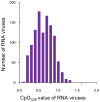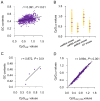CpG usage in RNA viruses: data and hypotheses
- PMID: 24086312
- PMCID: PMC3781069
- DOI: 10.1371/journal.pone.0074109
CpG usage in RNA viruses: data and hypotheses
Abstract
CpG repression in RNA viruses has been known for decades, but a reasonable explanation has not yet been proposed to explain this phenomenon. In this study, we calculated the CpG odds ratio of all RNA viruses that have available genome sequences and analyzed the correlation with their genome polarity, base composition, synonymous codon usage, phylogenetic relationship, and host. The results indicated that the viral base composition, synonymous codon usage and host selection were the dominant factors that determined the CpG bias in RNA viruses. CpG usage variation between the different viral groups was caused by different combinations of these pressures, which also differed from each other in strength. The consistent under-representation of CpG usage in -ssRNA viruses is determined predominantly by base composition, which may be a consequence of the U/A preferred mutation bias of -ssRNA viruses, whereas the CpG usage of +ssRNA viruses is affected greatly by their hosts. As a result, most +ssRNA viruses mimic their hosts' CpG usage. Unbiased CpG usage in dsRNA viruses is most likely a result of their dsRNA genome, which allows the viruses to escape from the host-driven CpG elimination pressure. CpG was under-represented in all reverse-transcribing viruses (RT viruses), suggesting that DNA methylation is an important factor affecting the CpG usage of retroviruses. However, vertebrate-infecting RT viruses may also suffer host' CpG elimination pressure that also acts on +ssRNA viruses, which results in further under-representation of CpG in the vertebrate-infecting RT viruses.
Conflict of interest statement
Figures




Similar articles
-
Genome polarity of RNA viruses reflects the different evolutionary pressures shaping codon usage.Arch Virol. 2018 Oct;163(10):2883-2888. doi: 10.1007/s00705-018-3930-7. Epub 2018 Jul 9. Arch Virol. 2018. PMID: 29987380
-
Causes and implications of codon usage bias in RNA viruses.PLoS One. 2013;8(2):e56642. doi: 10.1371/journal.pone.0056642. Epub 2013 Feb 25. PLoS One. 2013. PMID: 23451064 Free PMC article.
-
Categorizing host-dependent RNA viruses by principal component analysis of their codon usage preferences.J Comput Biol. 2009 Nov;16(11):1539-47. doi: 10.1089/cmb.2009.0046. J Comput Biol. 2009. PMID: 19958082
-
Evolution and host adaptability of plant RNA viruses: Research insights on compositional biases.Comput Struct Biotechnol J. 2022 May 17;20:2600-2610. doi: 10.1016/j.csbj.2022.05.021. eCollection 2022. Comput Struct Biotechnol J. 2022. PMID: 35685354 Free PMC article. Review.
-
Compositional biases in RNA viruses: Causes, consequences and applications.Wiley Interdiscip Rev RNA. 2022 Mar;13(2):e1679. doi: 10.1002/wrna.1679. Epub 2021 Jun 21. Wiley Interdiscip Rev RNA. 2022. PMID: 34155814 Free PMC article. Review.
Cited by
-
A comprehensive analysis of Usutu virus (USUV) genomes revealed lineage-specific codon usage patterns and host adaptations.Front Microbiol. 2023 Jan 12;13:967999. doi: 10.3389/fmicb.2022.967999. eCollection 2022. Front Microbiol. 2023. PMID: 36713228 Free PMC article.
-
The virome of the invasive Asian bush mosquito Aedes japonicus in Europe.Virus Evol. 2023 Jul 3;9(2):vead041. doi: 10.1093/ve/vead041. eCollection 2023. Virus Evol. 2023. PMID: 37636319 Free PMC article.
-
The low abundance of CpG in the SARS-CoV-2 genome is not an evolutionarily signature of ZAP.Sci Rep. 2022 Feb 14;12(1):2420. doi: 10.1038/s41598-022-06046-5. Sci Rep. 2022. PMID: 35165300 Free PMC article.
-
Dinucleotide Composition in Animal RNA Viruses Is Shaped More by Virus Family than by Host Species.J Virol. 2017 Mar 29;91(8):e02381-16. doi: 10.1128/JVI.02381-16. Print 2017 Apr 15. J Virol. 2017. PMID: 28148785 Free PMC article.
-
All About the RNA: Interferon-Stimulated Genes That Interfere With Viral RNA Processes.Front Immunol. 2020 Dec 9;11:605024. doi: 10.3389/fimmu.2020.605024. eCollection 2020. Front Immunol. 2020. PMID: 33362792 Free PMC article. Review.
References
Publication types
MeSH terms
Substances
Grants and funding
LinkOut - more resources
Full Text Sources
Other Literature Sources
Research Materials

